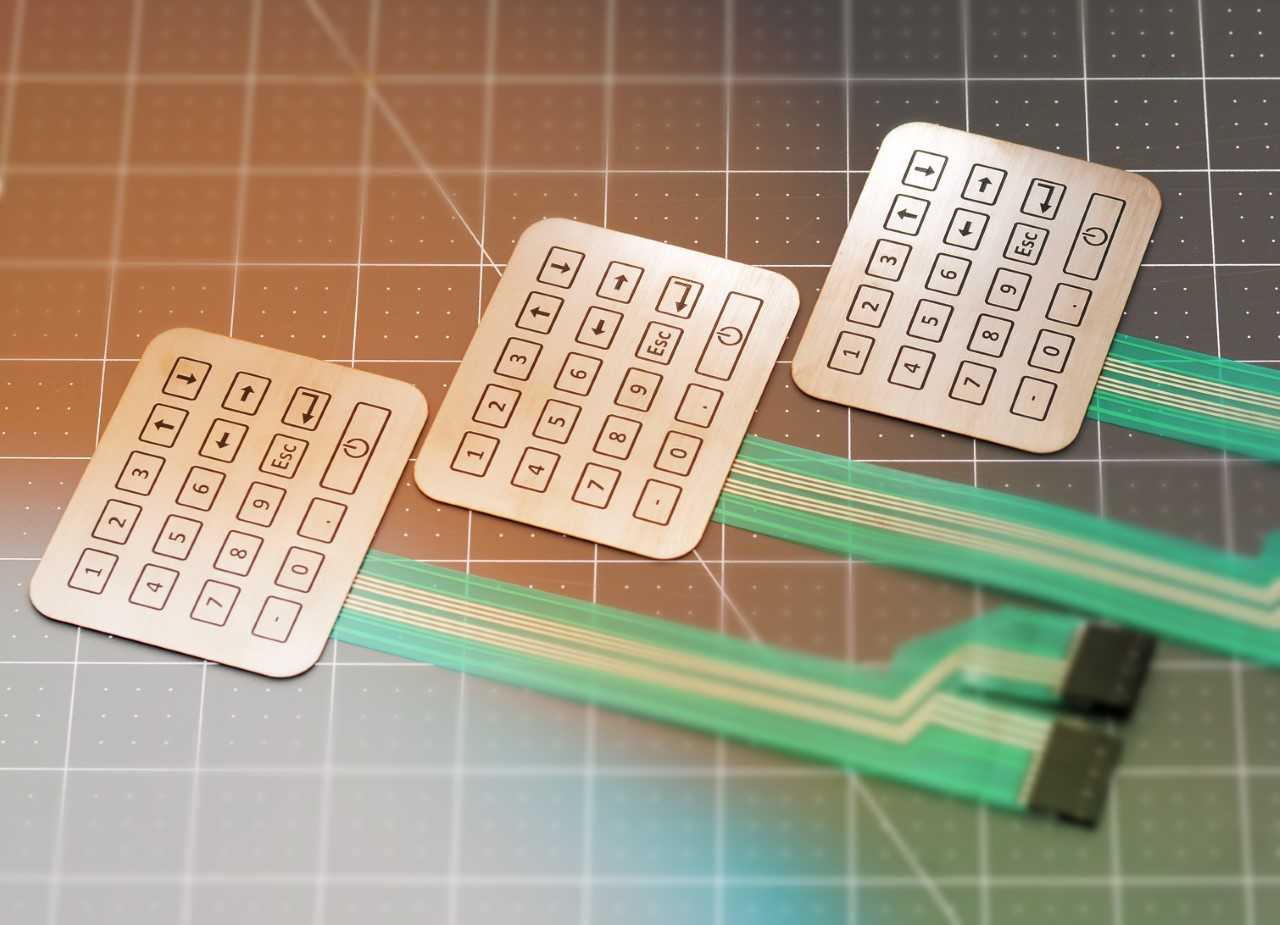Exactly How Membrane Switch Modern Technology Works and Its Duty in Customer User Interface Style
Membrane switch modern technology is a sophisticated approach that incorporates layered products for touch-sensitive input. Its layout consists of visuals overlays, conductive layers, and glue parts that interact when pushed. This communication not just completes an electric circuit however additionally affects the general user experience. Recognizing the complexities of this modern technology discloses its significant influence on interface design, provoking questions about its applications and future developments in numerous industries.
Understanding Membrane Switch Innovation
Membrane button technology functions as an essential part in contemporary user interface layout. This technology incorporates visuals overlays, touch-sensitive membranes, and circuit layers to produce a small, trusted input approach for various tools. The design normally contains numerous layers, consisting of a published visuals layer that permits individuals to connect with the tool with tactile responses. Membrane buttons are understood for their resilience, resistance to wetness, and convenience of cleansing, making them suitable for settings where standard mechanical switches may fall short. Their inconspicuous design enables seamless combination into devices, contributing to a streamlined appearance. Additionally, Membrane switches can be tailored with different shades, appearances, and symbols, improving customer experience and visual allure. This flexibility makes them prominent in customer electronic devices, clinical tools, and industrial controls, where user-friendly communication is essential. Overall, Membrane button technology stands for a considerable development in how individuals involve with digital user interfaces.
Key Parts of Membrane Changes
Membrane changes are composed of a number of essential components that add to their capability and style. The conductive layer products, glue and assistance layers, and graphic overlay design each play an important function in guaranteeing ideal performance and user communication. Understanding these parts is vital for effective interface style.
Conductive Layer Materials
Conductive layer products play a vital duty in the performance and integrity of Membrane buttons. When stress is applied to the button, these products are responsible for completing electrical circuits. Normally, a combination of conductive inks, such as silver or carbon, is used to develop these layers. Silver conductive ink is favored for its exceptional conductivity and toughness, while carbon ink is frequently made use of for affordable applications. The option of product affects not just the electrical efficiency but additionally the total lifespan of the button. In addition, the thickness and composition of conductive layers can influence tactile responses and button actuation. Picking the suitable conductive product is important for making certain suitable performance in diverse interface applications.
Glue and Assistance Layers
Sticky and assistance layers are essential components that contribute to the structural honesty and performance of Membrane switches. These layers give a robust structure, making certain that the numerous elements of the Membrane switch remain firmly adhered and appropriately lined up throughout their functional life. The sticky layer helps with the attachment of the switch to the underlying surface, offering toughness against ecological aspects such as moisture, temperature variants, and mechanical anxiety. Assistance layers enhance the switch's rigidness, stopping deformation throughout use and adding to a regular tactile feedback. Together, these elements play an important duty in keeping the efficiency and durability of Membrane switches, inevitably influencing the total user experience in user interface design.
Graphic Overlay Design
Although usually neglected, visuals overlay design plays a necessary duty in the functionality and looks of Membrane buttons. This layout mainly works as the interface in between the customer and the electronic devices, giving both visual appeal and functional quality. Efficient graphic overlays use color, typography, and symbols to assist individuals in steering controls and recognizing tool features. In addition, the choice of materials effects sturdiness and responsive feedback, making sure the overlay stands up to wear while maintaining a pleasurable individual experience. In addition, precise placement of the overlay with the underlying parts is important for excellent efficiency. To conclude, thoughtful graphic overlay layout improves use, adds to brand identification, and eventually influences user fulfillment in tools utilizing Membrane button technology.
The Manufacturing Process of Membrane Switches
The production process of Membrane changes entails a number of important actions that guarantee performance and longevity. Initially, a graphic overlay is created, including user interface elements and branding. This overlay is printed onto a versatile substrate, normally polyester or polycarbonate, making use of accuracy printing strategies to ascertain clarity and color accuracy.Next, sticky layers are used, adhered to by the assimilation of conductive traces, often made from silver or carbon, which are important for electrical connection. These traces are screen-printed or etched onto a separate layer. Hereafter, a spacer layer is included in produce the essential void in between the circuit and the overlay layer, permitting responsive comments when activated.Finally, the parts are constructed and examined for top quality guarantee, guaranteeing that each Membrane switch meets the required specifications for efficiency and dependability. This precise process results in a durable item fit for various applications in user interface style.
Benefits of Making Use Of Membrane Changes

Membrane changes deal many advantages that make them a recommended option in user interface layout. One considerable advantage is their small and lightweight nature, enabling streamlined layouts in different applications. In addition, Membrane buttons offer a secured interface, safeguarding versus dust, wetness, and contaminants, which improves resilience and dependability. wikipedia reference They are likewise very customizable, enabling designers to develop distinct graphics and formats customized to particular individual needs.Another advantage is their cost-effectiveness, as they typically need much less product and labor compared to typical switches. The tactile responses of Membrane buttons can be engineered to enhance customer experience, supplying a satisfying feedback without the mass of mechanical parts. Furthermore, Membrane switches can be conveniently incorporated into varied settings, such as clinical devices, industrial equipment, and consumer electronic read here devices. Overall, these advantages underscore the growing popularity of Membrane switches in contemporary individual interface layout.
Applications in Numerous Industries
Extensively made use of throughout numerous sectors, Membrane button modern technology has actually located its area in applications varying from clinical tools to customer electronics. In the medical care field, these buttons are integral to devices such as diagnostic tools and patient surveillance systems, supplying sturdy, easy-to-clean user interfaces that hold up against sanitation procedures. The auto market utilizes Membrane buttons in control panels and control board, supplying dependable operation in tough environments.Consumer electronic devices, including home appliances and gaming consoles, advantage from the streamlined style and customizability of Membrane buttons, improving user communication. In addition, industrial equipment utilizes these switches for control panels, making certain resistance to dirt and wetness while maintaining functionality.Moreover, the aerospace and military fields utilize Membrane buttons for rugged applications, where reliability and efficiency are crucial. On the whole, Membrane switch technology offers diverse industries by combining capability, longevity, and visual appeal, making it a functional choice for modern-day customer interfaces.

Designing Interface With Membrane Changes
When creating interface with Membrane switches, careful consideration of both functionality and appearance is crucial. Membrane switches provide a streamlined, low-profile layout that can boost aesthetic charm while preserving functionality. Designers must concentrate on switch layout, making sure user-friendly placement for ease of procedure. The responsive comments given by the Membrane switch is important; it can affect customer satisfaction and general experience.Additionally, color and graphic components must line up with the brand identity, reinforcing acknowledgment and knowledge. Selecting durable products that endure wear and tear is additionally crucial, as longevity adds to use in time. Integrating backlighting can improve visibility in various lighting problems, even more enhancing individual interaction. Inevitably, a well-designed Membrane switch interface balances both type and function, making certain that the individual experience is both engaging and effective, meeting the needs of diverse applications across sectors.
Future Fads in Membrane Switch Technology
As Membrane switch modern technology advances, the assimilation of wise performances is coming to be progressively noticeable. These improvements enable improved interactivity and connection within interface (membrane switch manufacturer). In addition, the shift in the direction of environment-friendly products reflects a growing dedication to sustainability in layout methods
Smart Membrane Switches Over

Eco-Friendly Products Use
Amidst the innovations in Membrane button technology, a substantial trend is arising towards the use of green materials. Makers are significantly focusing on sustainability by incorporating safe inks and biodegradable plastics, minimizing ecological influence. This change not just aligns with worldwide environmental requirements yet additionally addresses consumer demand for greener items. Developments in material scientific research have actually made it possible for the growth of sturdy, eco-friendly options that maintain performance without jeopardizing top quality. These products use comparable functionality to conventional choices while lessening waste and toxicity. As markets end up being much more eco-conscious, the combination of sustainable practices in Membrane button manufacturing is anticipated to increase, strengthening a commitment to environmental duty and paving the means for even more sustainable individual interface services in the future.
Frequently Asked Inquiries
Exactly How Do Membrane Changes Differ From Standard Mechanical Switches?
Membrane changes differ from standard mechanical buttons mainly in construction and procedure. They use flexible layers that develop a sealed user interface, whereas mechanical buttons count on physical activity and get in touch with, resulting in distinctive longevity and tactile feedback characteristics.
Can Membrane Switches Be Personalized for Specific Applications?
Membrane buttons can undoubtedly be customized for certain applications - membrane switch manufacturer. Producers make them to meet distinct requirements, permitting for tailored designs, graphics, and functionalities that improve user interaction and fit certain operational requirements effectively
What Is the Life expectancy of a Membrane Layer Switch?
The life expectancy of a membrane layer switch usually ranges from 1 to 5 million actuations, relying on variables such as worldly high quality, ecological conditions, and use regularity. Regular screening can aid determine its durability and dependability in applications.
Are Membrane Switches Over Water Resistant or Immune to Chemicals?
Membrane buttons can be developed to be immune and waterproof to chemicals, depending on the materials utilized and making processes. Proper sealing and protective coverings improve their longevity in various environmental problems and applications.
Just How Do Membrane Switches Over Influence Tool Power Consumption?
Membrane switches can greatly impact device energy consumption by making certain efficient operation. Their low power demands during activation assistance lessen power use, adding to longer battery life and total better performance in digital gadgets. Membrane buttons are recognized for their toughness, resistance to dampness, and convenience of cleansing, making them appropriate for atmospheres where typical mechanical buttons might fall short. The vehicle market utilizes Membrane buttons in dashboards and control panels, giving reputable operation in challenging environments.Consumer electronics, consisting of home devices and pc gaming consoles, advantage from the smooth design and customizability of Membrane buttons, improving user communication. In addition, industrial equipment utilizes these buttons for control panels, making certain resistance to dust and moisture while keeping functionality.Moreover, the aerospace and army industries utilize Membrane switches for sturdy applications, where integrity and performance are crucial. The evolution of Membrane button innovation is entering an amazing stage with the emergence of clever Membrane buttons, which integrate advanced attributes and performances. Membrane changes differ from standard mechanical switches mainly in building and operation.